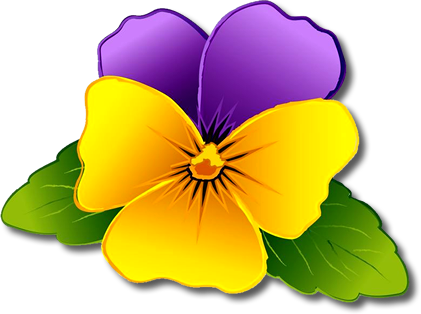
04 Happy Bee Garden Center
June 27, 2020
06 Emerisa Gardens Nursery
July 21, 2020Bang-For-Your-Buck Plants
T o me, a "Bang-For-Your-Buck Plant" is a plant that gives me a lot for my dollar—in size, in its ability to live a quiet life alone as a specimen or focal point in the landscape, and in its WOW factor. Doubting a plant can give me these, is one of my reasons for telling Aunt Patti, "NO, that plant WON'T work!"
In choosing a BFYB plant for a particular landscape, I pick one that I can build a design around and make it work within a 3'x3' space. Any bigger and I can become overwhelmed and need to walk back in the house to have a drink...of water.
Here are some of my favorite BFYBs!
Cotoneaster horizontalis Rock Cotoneaster
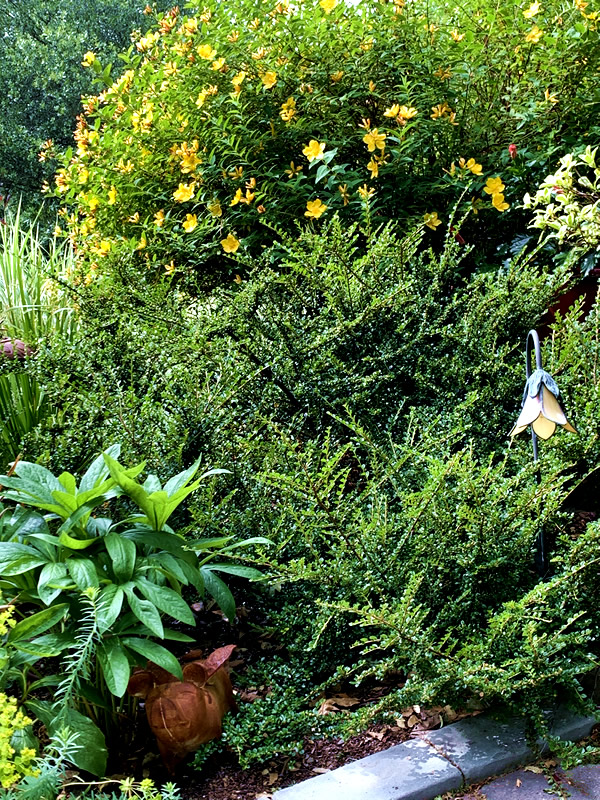
This plant can fill a 6' wide by 2' tall space in just a few years. I’ve had mine for over 15 years, but I do prune it with clippers (NOT electric hedge trimmers!) to keep it at 5' wide. The deer will not eat it, the birds love its red berries, it covers itself with beautifully colored foliage in the Fall, and after it grows new foliage in spring, it is a pretty dark green.
A one-gallon costs around $9.99. It is deciduous, so it is best to put some evergreen plants around it so you won’t have a complete bare spot through winter months.
Surrounding my Cotoneaster, I have Lomandra hystrix ‘Katie Belles’ (left center), Helleborus orientalis ‘Onyx Odyssey’ (left bottom) and Hypericum perforatum St. John’s Wort (top). Wilbur the pig is there too taking shelter.
You might question my thinking because the Cotoneaster and Hypericum are full sun plants, Helleborus is part shade as is the Lomandra (this particular species). But there is a nearby tree that provides shade where needed. The rest is in full sun.
Also in the photo is a stained-glass Star Lily which is actually my low volt lighting. I came upon Stone Manor Lighting 22 years ago at the infamous San Francisco Flower & Garden Show at the Cow Palace (sigh...), now held in Sacramento but don’t waste your time or money—it is NOT like it used to be. Even Aunt Patti agrees. Who wants windows and spas when shopping for flowers!!!!!
Euphorbia 'Blackbird' (center)
With Cedrus deodara ‘Feelin Blue’ (bottom), Dianthus carthusianorum (right),
Echinacea ‘Sombrereo Lemon Yellow’ (top)
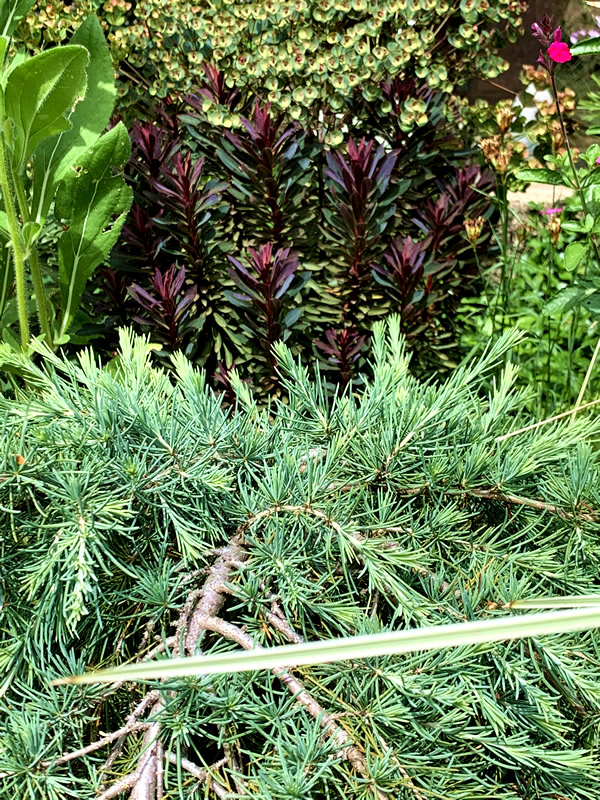
I don’t know why more people do not put Euphorbias in their gardens. They are BFYB plants because they 1) are evergreen, 2) put out unusual bracts (flowers) early spring to mid-summer, 3) have varying foliage colors, 4) are excellent for mass planting, 5) are extremely hardy, 6) have great structure, 7) reseed (some do), 8) are drought tolerant—which does NOT mean NO water (do not get me started on that subject), rather NO soggy bottoms—and 9) the deer won’t eat them due to their poisonous milky sap, so no afternoon snacking (like who should be eating on ornamentals anyway, geez!).
A one-gallon runs around $8.95.
‘Blackbird’ is one of my favorite Euphorbias due to its burgundy foliage. When designing, I always look for foliage colors other than green! This plant can be finicky but well worth a shot. Mine have grown to at least 4'x 4' and they can grow to well over that.
Euphorbia 'Tasmanian Tiger'
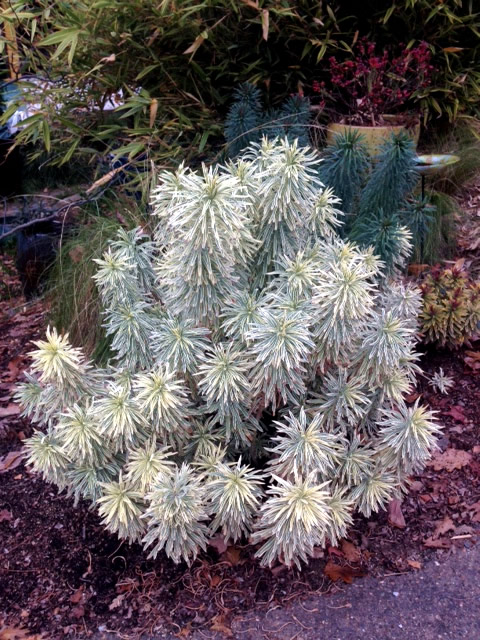
‘Tasmanian Tiger’ has always been my "One-and-Only" Euphorbia because it is bright and cheerful—just like me. We go way back, and it has never stood me up. It pops in the garden and, due to its variegated foliage that compliments yellow and magenta blossoms, looks lovely with just about any other plant.
Also try the ‘Ascot Rainbow’, ‘Glacier Blue’ and the freakin’ awesome, Euphorbia tirucalli ‘Firesticks’—which is fabulous in a succulent garden—though it can be pricey if you don’t shop around. I saw one at a local nursery for $50 (NOT a BFYB plant in that place!!!!) then went to Home Depot where it was $19.99 in the same size pot. Bought two.
Cordyline ‘Cha Cha’
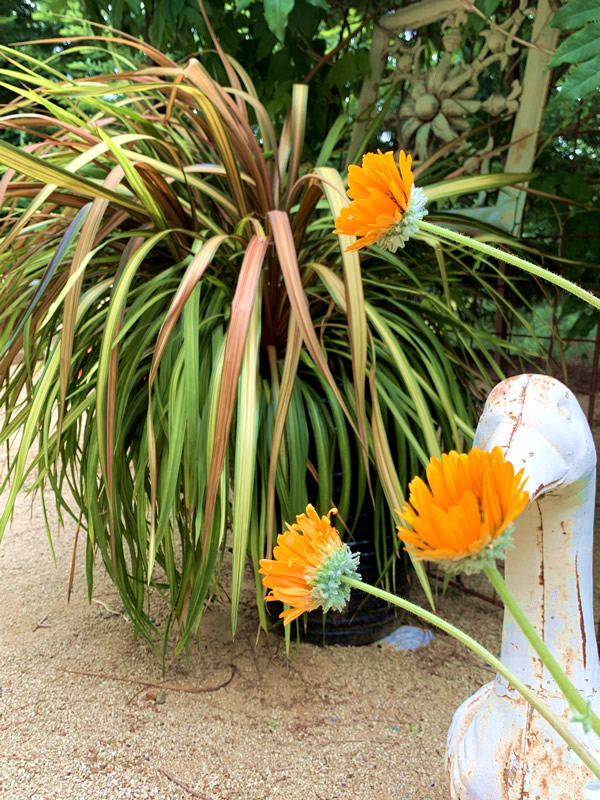
I bought my Cordyline ‘Cha Cha’ about 3 years ago in a 2-gallon for $12. (There was only one on the shelf, so poor Aunt Patti couldn’t have one.)
The 'Cha Cha' has variations of colors through the seasons. I put it in a black container and placed it in filtered sun. I added a Heuchera Lime Marmalade and a Lysimachia congestiflora ‘Persian Chocolate’ which can barely be seen because the 'Cha Cha' has taken over. I loved this BFYB plant so much I bought another one and put it in the ground.
Cordyline banksii ‘Electric Pink’
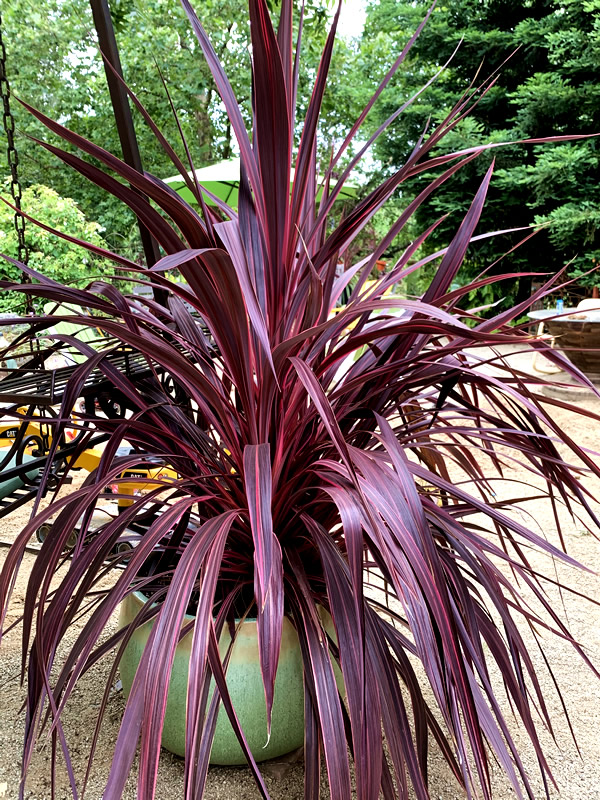
I bought the Cordyline banksii ‘Electric Pink’ a year ago for my daughter’s wedding held in my gardens. Her color was burgundy, so instead of doing flowers, I focused on foliage.
I really am a Foliage Gal. Flowers are pretty but foliage lasts longer.
I am going to use the word "stunning" again, because every day I see this Cordyline and it absolutely amazes me. Generally when you put a perennial in a container, it can only get as big as the roots are allowed to grow. So I put it in a big container (which looks tiny compared to the plant), but now it has grown taller and wider than expected (4'x3') and is top-heavy because and it is located in part sun.
I have seen 'Electric Pink' planted in full sun in temperatures of 100-degrees and above. But they lose that deep dark burgundy color and instead turn light pink. They don't grow as large because they're not as happy.
I use this plant for contrast and to draw the eye to a specific location in the landscape. Then I design around it or let it be a loner.
Cordyline ‘Can Can’
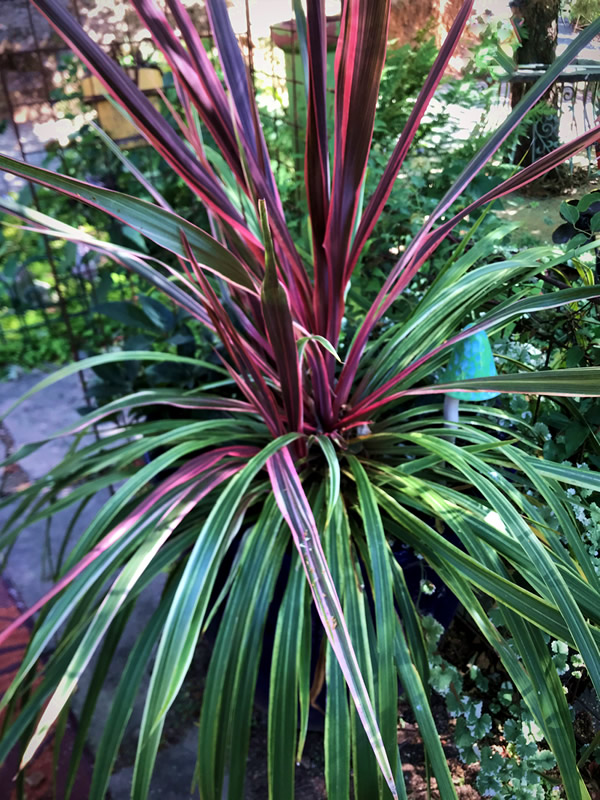
The Cordyline ‘Can Can’ was the first Cordyline I purchased. Its interior blades are pink, while the exterior blades are green variegated. It stands more erect than the other Cordylines.
These plants do not like frost, so I was reluctant to buy them until recently as hardier species have come on the market. I take extra precautions though and have placed them under tree canopies for protection because I do get snow some years at my place and have been known to run out in my PJs with a stick for whacking the snow off my plants!
Just know that Cordylines are expensive. But the WOW factor is well worth the price.
Woodwardia fimbriata Giant Chain Fern
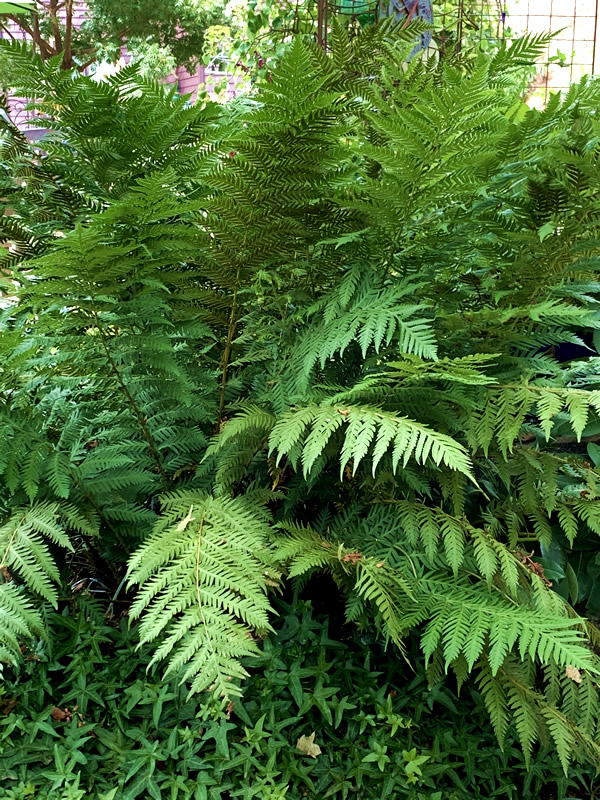
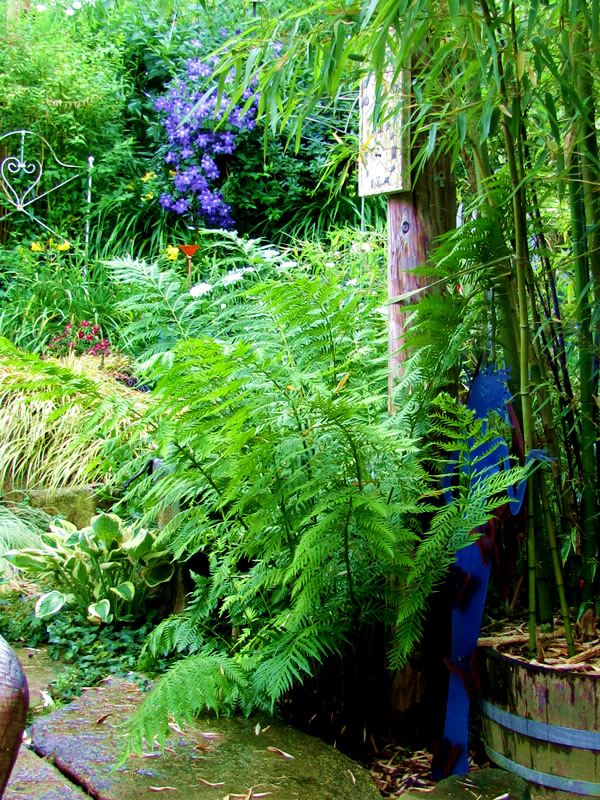
Snow, frost, heat (part shade), rain—nothing deters these ferns from putting on a show year round. Which means they are evergreen. They can get to 5' tall and 5' wide or larger. In my gardens I have 5 of these that provide structure and balance. I pair them with Rhododendrons, Azaleas, Helleborus, Hydrangeas, and Choisyas, and they have even given me babies growing 8 to 10 feet away from the mother. This took years but who is complaining? Not me!
Lomandra longifolia 'Platinum Beauty'
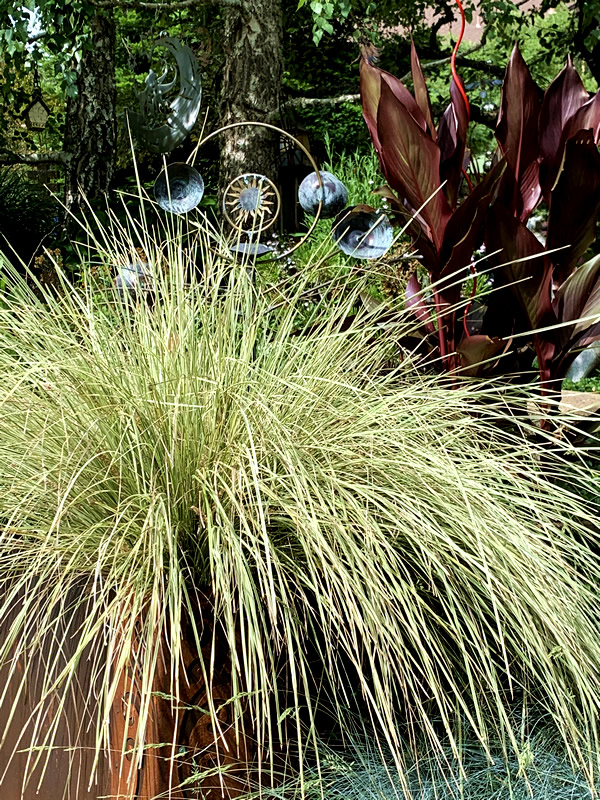
And finally—at least for this post—the lovely 'Platinum Beauty.' If you can’t go blonde, buy blonde!
This genus was highly under-utilized until recent years. It made my BFYB plant list because it 1) is truly drought tolerant once established, which means one growing season, 2) is evergreen, 3) grows to 3'x3', 4) is light and airy, 5) takes on the role of an ornamental grass but is not a grass so do NOT cut it down unless damaged by weather (it has a slow comeback), and 6) pairs well with Mediterranean plants—which happen to pair well with my planting zone!
You cannot go wrong with sticking a Lomandra in your landscape. Or maybe 15 for a mass planting!
All photographs in this post courtesy Sheri Lynn Burke. All rights reserved.

